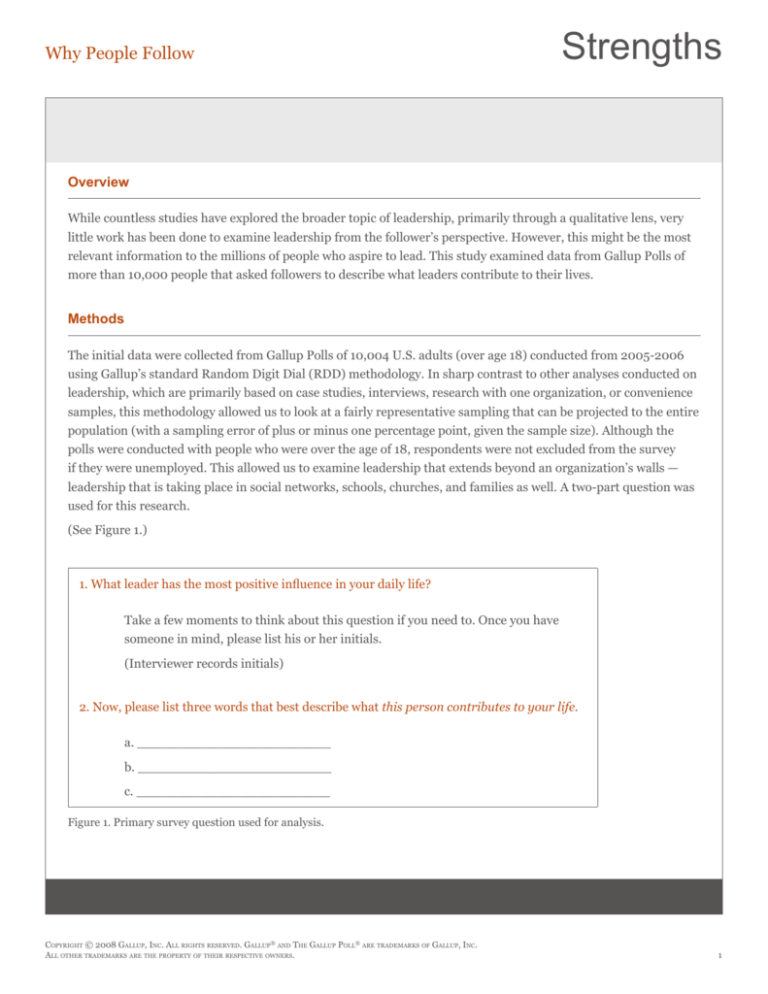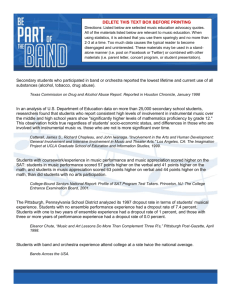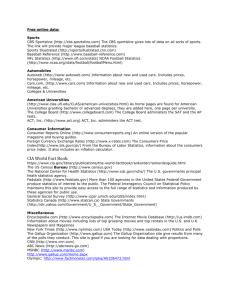
Why People Follow
Strengths
Overview
While countless studies have explored the broader topic of leadership, primarily through a qualitative lens, very
little work has been done to examine leadership from the follower’s perspective. However, this might be the most
relevant information to the millions of people who aspire to lead. This study examined data from Gallup Polls of
more than 10,000 people that asked followers to describe what leaders contribute to their lives.
Methods
The initial data were collected from Gallup Polls of 10,004 U.S. adults (over age 18) conducted from 2005-2006
using Gallup’s standard Random Digit Dial (RDD) methodology. In sharp contrast to other analyses conducted on
leadership, which are primarily based on case studies, interviews, research with one organization, or convenience
samples, this methodology allowed us to look at a fairly representative sampling that can be projected to the entire
population (with a sampling error of plus or minus one percentage point, given the sample size). Although the
polls were conducted with people who were over the age of 18, respondents were not excluded from the survey
if they were unemployed. This allowed us to examine leadership that extends beyond an organization’s walls —
leadership that is taking place in social networks, schools, churches, and families as well. A two-part question was
used for this research.
(See Figure 1.)
1. What leader has the most positive influence in your daily life?
Take a few moments to think about this question if you need to. Once you have
someone in mind, please list his or her initials.
(Interviewer records initials)
2. Now, please list three words that best describe what this person contributes to your life.
a. ________________________
b. ________________________
c. ________________________
Figure 1. Primary survey question used for analysis.
Copyright © 2008 Gallup, Inc. All rights reserved. Gallup® and The Gallup Poll® are trademarks of Gallup, Inc.
All other trademarks are the property of their respective owners.
1
Why People Follow
Strengths
The first part of the question asked respondents to identify a specific leader, which required them to isolate the
person who has the most positive influence on their life. In theory, asking respondents to provide initials for one
specific person likely helped them to identify more specific contributions in the second part of this question. The
use of the word “positive” was important because we didn’t want to study leaders who have a predominantly negative influence. The last three words of the first part of the question — “your daily life” — were critical to examining
the type of leadership that makes a tangible and practical difference on a day-to-day basis. This differentiated the
question even more from the typical “Whom do you admire most?” or Who is the best leader you know?” questions that Gallup and others have asked in the past. Questions like these often result in respondents naming major
political, religious, and athletic celebrities.
After respondents identified the leader they were thinking about, Gallup interviewers asked them to list three
words that “best describe what this person contributes to your life.” It is important to note the focus on what the
leader contributes to the follower’s life. Again, traditional studies have concentrated on the qualities of the leader
herself and would have framed this question around descriptions of the leader’s style. In contrast, the question
asked in this survey identifies what the leader is actually adding to the follower’s life, which is a very different
question. Perhaps most importantly, the fact that Gallup’s survey asked for just three words per person made it
substantially easier to analyze the content from these surveys, particularly when compared to more open-ended
questions.
The word responses were compiled into a single Microsoft Excel file for cleaning and coding. First, the Excel
spelling tool was used to find and correct spelling errors in the responses. In certain cases, the Merriam-Webster
Online Dictionary was also used to fix spelling errors. Second, any duplicate responses given by a respondent were
identified and removed from the word response file. Next, cases where respondents provided more than one word
per response were identified. If it was clear that the additional words represented separate concepts, then these
additional words were separated out and considered additional responses. Finally, any responses that were unintelligible or that could be considered non-responses were identified and coded.
Once the cleaning and coding stage of the word responses was complete, the data were weighted to be more representative of the U.S. population, and the first three responses from each respondent were removed from the file
for word frequency analysis. A weighted word frequency count was conducted on all of the responses. The counts
for each response were ranked from highest to lowest frequency to identify a set of the most frequently mentioned
words that best describe what everyday leaders contribute to the lives of the respondents.
Copyright © 2008 Gallup, Inc. All rights reserved. Gallup® and The Gallup Poll® are trademarks of Gallup, Inc.
All other trademarks are the property of their respective owners.
2
Why People Follow
Strengths
Results and Future Research
The primary results of this research are presented in Part Three of Strengths Based Leadership. Based on our
initial studies of 10,004 people, the following key themes (or basic needs) emerged:
• Trust (other words cited by followers included: honesty, integrity, and respect)
• Compassion (other words cited by followers included: caring, friendship, happiness, and love)
• Stability (other words cited by followers included: security, strength, support, and peace)
• Hope (other words cited by followers included: direction, faith, and guidance)
As we reviewed the research based on the initial question in Figure 1, we found that more than 85% of respondents selected someone they described as a friend, family member, coworker, teacher, or current manager/immediate supervisor. In the vast majority of cases, the leader who had the most impact was someone very close to the
person answering the survey.
What’s more, people mentioned a leader they had known for a long time. Another question on this survey was:
“How long have you known this person?” and the most common response was 10 years. More than 75% of the
people we surveyed named a person they had know for six or more years, and 90% said they had known the person for three or more years.
To determine if followers have similar needs when it comes to higher level organizational and global leaders, we
conducted another study in 2008. For this study, we surveyed an additional 1,000 U.S. adults (over age 18) using
Gallup’s standard Random Digit Dial (RDD) methodology. This time, we modified the question wording and asked
respondents specifically about an “organizational leader” and a “global leader.” We also removed the word “daily”
to ensure that we were asking about a different level of leadership with these new questions. We used the same
follow-up language requesting three words that best describe what this person contributes to the respondents’ life.
(See Figure 2 and Figure 3.)
Copyright © 2008 Gallup, Inc. All rights reserved. Gallup® and The Gallup Poll® are trademarks of Gallup, Inc.
All other trademarks are the property of their respective owners.
3
Why People Follow
Strengths
1. What organizational leader has the most positive influence in your life?
Take a few moments to think about this question if you need to. Once you have
someone in mind, please list his or her initials.
(Interviewer records initials)
2. Now, please list three words that best describe what this person contributes to your life.
a. ________________________
b. ________________________
c. ________________________
Figure 2. Second (organizational) survey question used for analysis.
1. What global leader has the most positive influence in your life?
Take a few moments to think about this question if you need to. Once you have
someone in mind, please list his or her initials.
(Interviewer records initials)
2. Now, please list three words that best describe what this person contributes to your life.
a. ________________________
b. ________________________
c. ________________________
Figure 3. Third (global) survey question used for analysis.
Copyright © 2008 Gallup, Inc. All rights reserved. Gallup® and The Gallup Poll® are trademarks of Gallup, Inc.
All other trademarks are the property of their respective owners.
4
Why People Follow
Strengths
After reviewing the responses to the modified questions, to our surprise, very little had changed. The sequence of
words in the Compassion domain did change slightly compared to the initial study (i.e., a smaller percentage of
people used the word “caring,” and a larger percentage used the word “compassion”). Yet overall, the same categories and words appeared with remarkable consistency.
The next phase of this follower study (which is currently in progress) will examine the core research question in
several countries around the globe. At the time of publication of Strengths Based Leadership, studies of more than
1,000 adults were underway — using Gallup’s standard RDD methodology — in the following countries:
• Australia
• Brazil
• Canada
• China
• India
• Japan
• New Zealand
• Singapore
• Thailand
We have conducted a preliminary review of these data from the predominantly English-speaking countries of
Australia, Canada, and New Zealand, where translations of the “please list three words” question were not necessary. Based on this initial review, it appears that followers are using a remarkably similar set of words to describe
what they expect of leaders in these three countries. However, a more detailed analysis will be conducted once
data from several more countries have been collected. We plan to publish these findings on Gallup’s website and
in future international editions of Strengths Based Leadership.
Copyright © 2008 Gallup, Inc. All rights reserved. Gallup® and The Gallup Poll® are trademarks of Gallup, Inc.
All other trademarks are the property of their respective owners.
5







